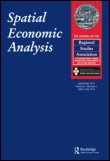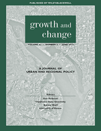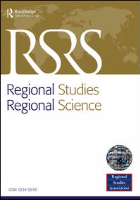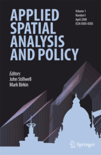
Spatial Economic Analysis
Scope & Guideline
Navigating the Complexities of Spatial Economics
Introduction
Aims and Scopes
- Spatial Econometrics and Modeling:
The journal emphasizes the development and application of spatial econometric models to analyze various economic phenomena, focusing on how spatial relationships impact economic outcomes. - Regional Development and Policy Analysis:
Research published in the journal often addresses issues of regional development, exploring the effects of policies and economic activities on local and regional economies. - Innovation and Knowledge Spillovers:
The journal highlights studies that investigate the role of innovation, knowledge spillovers, and human capital in shaping regional economic dynamics. - Urban and Rural Economic Interactions:
A significant focus is placed on the economic interactions between urban and rural areas, including the effects of urbanization on regional economic structures. - Sustainability and Environmental Economics:
The journal includes research on the spatial dimensions of sustainability, exploring how economic activities intersect with environmental concerns.
Trending and Emerging
- Spatial Data Integration and Machine Learning:
An increasing number of studies are leveraging machine learning techniques to analyze spatial data, indicating a trend towards integrating advanced computational methods with spatial economic analysis. - Impact of COVID-19 on Spatial Economies:
Research focusing on the spatial economic impacts of the COVID-19 pandemic is becoming prominent, as scholars explore how the crisis affected regional economies and labor markets. - Dynamic Spatial Models:
There is a growing emphasis on dynamic spatial models that account for time-varying relationships, reflecting the need for more nuanced understandings of spatial economic dynamics. - Sustainability and Climate Change Economics:
Emerging themes related to sustainability and climate change are increasingly featured, with studies examining the spatial implications of environmental policies and economic resilience. - Migration and Mobility Studies:
The journal is seeing a rise in research related to migration patterns and their economic implications, highlighting the importance of understanding demographic changes in spatial contexts.
Declining or Waning
- Traditional Economic Theories:
There seems to be a waning interest in traditional economic theories that do not incorporate spatial dimensions, as the journal shifts towards more complex and integrated spatial models. - Static Economic Analyses:
Static analyses that do not account for dynamic changes over time are becoming less frequent, replaced by more dynamic approaches that consider temporal variations in spatial economic interactions. - Generalized Economic Models without Spatial Considerations:
There is a noticeable decline in the publication of generalized economic models that fail to incorporate spatial factors, reflecting a shift towards models that explicitly account for spatial interactions.
Similar Journals

GROWTH AND CHANGE
Navigating the challenges of a rapidly changing world.GROWTH AND CHANGE is a prestigious academic journal published by Wiley, focusing on the interdisciplinary study of global and planetary change. Since its inception in 1970, this journal has served as a critical platform for researchers and scholars who seek to explore the complexities of social, economic, and environmental transformations occurring worldwide. With an impressive impact factor and renowned for its rigor, it currently holds a Q2 ranking in the Global and Planetary Change category as per the latest metrics. GROWTH AND CHANGE can be accessed through traditional subscriptions, catering to a broad audience including professionals and academic institutions. Its objectives revolve around advancing knowledge and fostering critical discussions that illuminate the challenges posed by rapid change and growth in our environments. Positioned at the forefront of debates in sustainability and development, this journal is indispensable for anyone vested in understanding and addressing the interconnected issues of our changing world.

Review of Regional Research-Jahrbuch fur Regionalwissenschaft
Innovating Knowledge in Regional Science and PlanningReview of Regional Research-Jahrbuch fur Regionalwissenschaft, published by SPRINGER HEIDELBERG, is a pivotal academic journal dedicated to the interdisciplinary exploration of regional science, economics, and geographical studies. With a strong presence in Germany and an impressive range of topics, this journal serves as a vital platform for scholars, researchers, and practitioners aiming to advance knowledge in regional development and planning. The journal has achieved notable recognition, being categorized in the Q3 quartile in Economics and Econometrics and Q2 in both Geography, Planning and Development and Social Sciences (miscellaneous), highlighting its importance in contemporary academic discourse. The Scopus rankings further affirm its relevance, with an impressive percentile ranking across its categories. Although it operates under traditional access options, the journal's robust editorial oversight ensures high-quality research dissemination from 1998 through 2024, making it essential for anyone invested in the critical dynamics of regional studies.

PAPERS IN REGIONAL SCIENCE
Innovating solutions through interdisciplinary research.PAPERS IN REGIONAL SCIENCE, published by Wiley, is a leading international journal dedicated to advancing the understanding of regional science and interdisciplinary approaches to geography and environmental planning. With an impressive impact factor and a prestigious Q1 ranking in both Environmental Science and Geography, Planning and Development, this journal serves as a critical platform for disseminating high-quality research from 1955 to 2024. Covering a diverse scope including regional development, spatial analysis, and environmental issues, it facilitates discussion and knowledge exchange among scholars and practitioners. The journal is recognized for its rigorous peer-review process and its commitment to addressing pressing societal challenges through research. As a vital resource for researchers, professionals, and students alike, PAPERS IN REGIONAL SCIENCE fosters innovation and collaboration within the field, contributing to a deeper understanding of the complexities of regional systems.

Regional Studies Regional Science
Connecting Economic, Social, and Environmental LandscapesRegional Studies Regional Science is a pioneering journal published by Routledge Journals, Taylor & Francis Ltd, specializing in the interdisciplinary examination of regional dynamics and their effects on economic, social, and environmental landscapes. Established as an open-access journal since 2014, it ensures widespread dissemination of knowledge, promoting accessibility for researchers, professionals, and students alike. Based in the United Kingdom, this journal has garnered a notable reputation, holding a Category Quartile ranking of Q2 in 2023 across various fields, including Economics and Econometrics, Geography, Planning and Development, and Sociology and Political Science. Its rankings in the Scopus database reflect its growing influence within the social sciences, positioning it as a valuable resource for contemporary regional studies. With a commitment to high-quality research, Regional Studies Regional Science serves as a vital platform for the exchange of innovative ideas and empirical findings that address the pressing challenges faced by regions worldwide.

Applied Spatial Analysis and Policy
Elevating research to drive effective spatial policies.Applied Spatial Analysis and Policy, published by Springer, is a leading journal dedicated to advancing knowledge in the field of spatial analysis and its application in policy-making. With an ISSN of 1874-463X and an E-ISSN of 1874-4621, this peer-reviewed journal has been at the forefront of geographical research since its inception in 2009 and continues to thrive with a convergence extending to 2024. As a recognized publication in the Geography, Planning and Development category, it holds a commendable Q2 quartile ranking for 2023 and is positioned at rank #238 out of 821 in the Scopus classification, reflecting its strong impact and relevance within the academic community with a percentile of 71. The journal provides a robust platform for researchers and professionals to explore innovative methodologies and empirical studies that enrich spatial policy frameworks. While access to individual articles is not open access, its significant contribution to the field makes it a vital resource for anyone involved in spatial analysis and related disciplines.

ANNALS OF REGIONAL SCIENCE
Innovating Insights into Spatial EconomicsThe ANNALS OF REGIONAL SCIENCE, published by SPRINGER, is a premier academic journal that has been disseminating impactful research since its establishment in 1967. With a distinguished focus on regional science, this journal serves as a vital platform for scholars, policymakers, and practitioners interested in understanding the spatial dynamics of economic and environmental phenomena. Boasting a Q1 ranking in Social Sciences and a Q2 ranking in Environmental Science, the journal effectively bridges disciplines, fostering interdisciplinary dialogue and innovation. The journal's rigorous peer-review process ensures the highest standards of academic integrity, making it a crucial resource for anyone involved in regional analysis and planning. As a testament to its global relevance, the ANNALS OF REGIONAL SCIENCE is indexed in Scopus, placing it among the top-tier journals in its field, with a commendable rank of #61 out of 275 in General Social Sciences and #100 out of 233 in General Environmental Science. Researchers, professionals, and students are encouraged to contribute to this essential body of work, as it continues to shape the discourse on regional development and environmental sustainability.

Review of Regional Studies
Innovating research in geography and planning.Review of Regional Studies, published by the SOUTHERN REGIONAL SCIENCE ASSOCIATION, is an open-access academic journal dedicated to advancing knowledge in the fields of regional science, geography, and planning. With an ISSN of 0048-749X and E-ISSN 1553-0892, this journal has made its contributions widely available online since 2011, ensuring accessibility for a global audience. The journal features a broad scope encompassing regional studies, aligning with current trends in environmental and urban research. Notably positioned within Q3 for both Earth-Surface Processes and Geography, Planning and Development categories for 2023, it presents rigorous analyses and insights from 1977 to the present, engaging researchers, practitioners, and students alike. Its rankings reflect its evolving impact in the social sciences and earth sciences, making it a vital resource for those interested in understanding the intricate dynamics of regional development and spatial interactions.

Raumforschung und Raumordnung-Spatial Research and Planning
Advancing spatial knowledge for a sustainable future.Raumforschung und Raumordnung - Spatial Research and Planning (ISSN: 0034-0111, E-ISSN: 1869-4179), published by OEKOM VERLAG GMBH, is a prominent scholarly journal based in Germany, focusing on critical issues in spatial research and planning. Established in 1977, this Open Access journal has been providing free access to its content since 1998, allowing researchers, professionals, and students to engage with high-quality studies exploring the intricacies of urban studies, environmental science, and geography. With a notable impact in its field, evidenced by its Q2 ranking in Urban Studies and Q3 rankings in Earth and Planetary Sciences, the journal plays a vital role in fostering interdisciplinary dialogue, advancing knowledge, and influencing policies across various spatial domains. It continues to evolve and adapt, having converged its years of publication effectively, making it a valuable resource for anyone looking to stay informed on the latest trends and research within the realms of spatial planning and environmental analysis.

Regional Statistics
Innovative Perspectives on Regional IssuesRegional Statistics, published by the Hungarian Central Statistical Office, is a leading scholarly journal that plays a pivotal role in enhancing the understanding of regional development and statistical analysis. With its ISSN 2063-9538 and E-ISSN 2064-8243, this open-access journal contributes significantly to various fields, including Cultural Studies, Economics, Geography, and Public Administration. The journal has established itself with impressive Scopus rankings, placing it in the top percentiles across multiple categories, evidencing its high-quality research outputs. Covering converged years from 2015 to 2024, Regional Statistics publishes insightful articles that address pressing regional issues, making it an invaluable resource for researchers, professionals, and students alike who are interested in the quantitative dimensions of society. With a reputation bolstered by its Q1 and Q2 categorizations in various disciplines, this journal is not only committed to advancing statistical knowledge but also to fostering interdisciplinary dialogue among statisticians, policymakers, and social scientists.

Ekonomia i Prawo-Economics and Law
Exploring the Synergy Between Economic Theory and Legal Frameworks.Ekonomia i Prawo-Economics and Law is a distinguished open-access journal published by the Nicolaus Copernicus University, based in Torun, Poland. With its ISSN 1898-2255 and E-ISSN 2392-1625, this journal has dedicated itself to advancing scholarship in economics and law since its inception in 2005. Aimed at fostering interdisciplinary dialogues, it serves as a vital resource for researchers, professionals, and students who seek to explore the intersections between economic theory and legal frameworks. By embracing open access, the journal promotes widespread dissemination of knowledge, contributing to a more informed and engaged academic community. The journal is committed to high-quality research output, ensuring relevance and rigor through a peer-reviewed editorial process. With a growing impact in the field, Ekonomia i Prawo stands as a crucial platform for significant contributions in economics and law studies, supporting both theoretical advancements and practical applications.